Wrap-up Review of Spring 2021 Haute Couture Fashion Week
Transforming Haute Couture From the Heritage Houses to the Vanguard Independents
With cinema, live-stream broadcasts, and prerecorded tapings, Spring’s spirited couture comes alive
By Long Nguyen
The second digital Paris spring-summer 2021 haute couture season that ended last week was considered a success with a solid showing from Dior, Chanel, and Valentino – at these houses where the focus on the actual couture clothes still matter and perhaps even a high priority.
It is undoubtedly a testimony to the resilience and the commitment these three heritage houses placed on the value of their haute couture, both as a commercial enterprise, and more importantly, as a remarkable efflorescence of craft and imagination in the creating, not just the unique clothes, but also the cultivation of the vision of an authentic brand.
There is also an haute couture underground composing of a crop of new designers recently entering the couture arena – the duo Nana Aganovich and Brooke Taylor at Aganovich, Ronald van der Kemp, S.R. STUDIO, LA. CA. by Sterling Ruby and Iris van Herpen. These independent designers are all stepping up to the occasion to change and remake in their ways the culture and values of couture – they respond to the turbulent social, political, and cultural changes occurring worldwide and respond to these shifts with their fashion.
Kim Jones’s debut at Fendi as the new artistic director for couture and womenswear was the most awaited show of this season that ended in disappointments rather than loud cheers. The superficial and excessive decor and the supermodel cast overshadowed the actual couture clothes that did not show any complex fashion ideas.
Demi Moore with another brand new face, the mother and daughter Kate Moss and her daughter Lila Moss, Christy Turlington, Bella Hadid, Naomi Campbell, Cara Delevigne, and the supermodel guys Ludwig Wilsdorff and James Turlington led the superstar cast. The sky-high budget million euro staging set by Bureau Betak filled the entire floor of the old stock market trading building Palais Brongniart with compositions of transparent glass structures of the double FF brand logo.
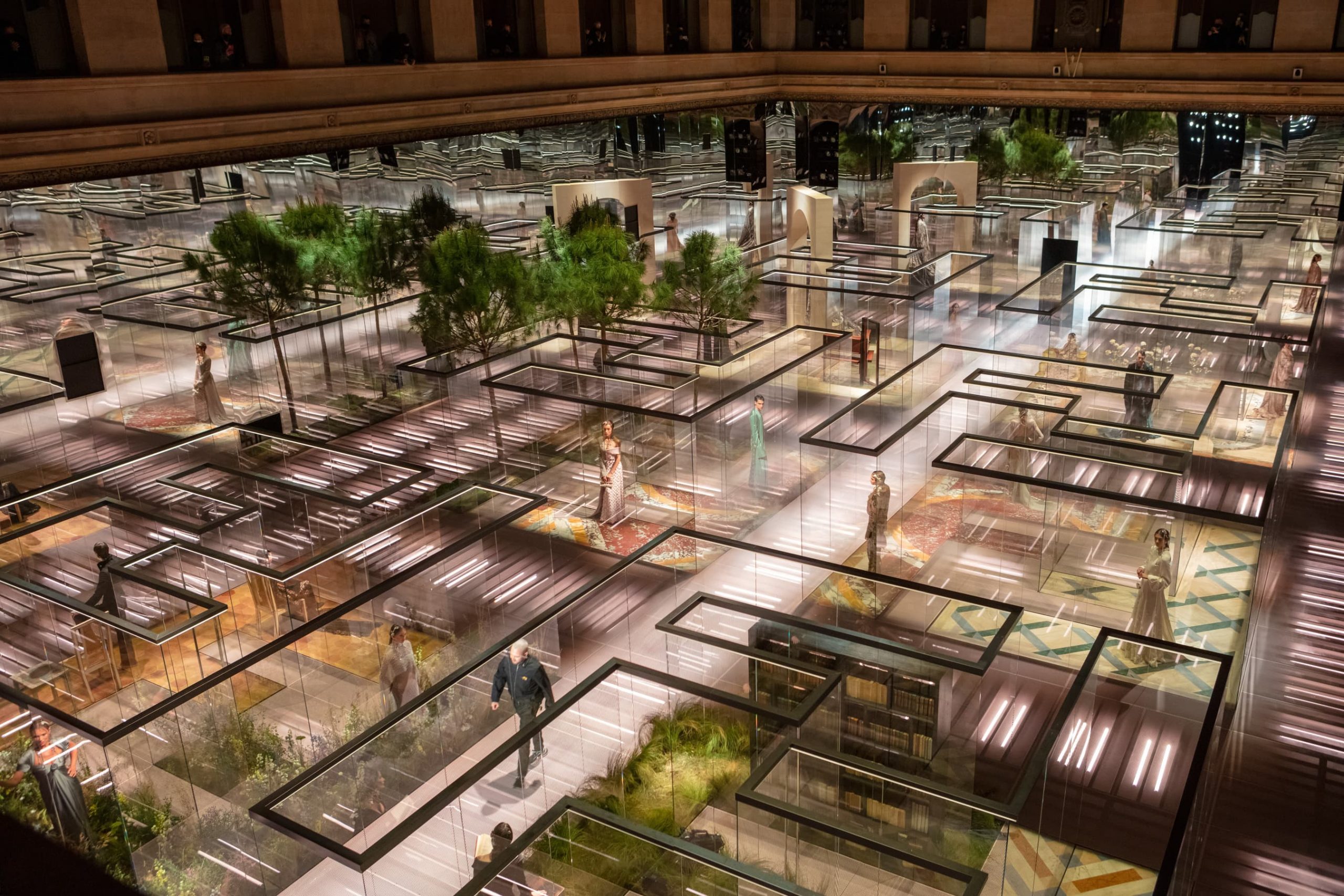
The craftsmanship of the Roman atelier shone brightly on these Fendi garments and is unmatched. The elaborately rose flower embroidered on an ivory silk cady long sleeve flared dress or the black macramé long dress with the train embroidered with paillettes felt more like the kind of clothes from a costly luxury ready to wear collection than old-style couture. Despite all the intellectual gift wrappings, still, the rose and gray suit in a white and pink marble palette, layered atop an ivory silk tulle pleated shirt with turquoise and bronze pearls – elaborate and complicated as that description may sound, didn’t quite deliver the couture quotient to capture the audience.

While emphasizing the theme of Virginia Wolf’s novel Orlando, Kim Jones, the new artistic director for couture and womenswear, did little to provide the kind of clothes that speak to the professed theme of transgressions, eviscerating the boundaries of time, of cultures, and genders. The confluence of literature, art, and culture somehow miss their tangencies on these decorated, well-made clothes ‘surfaces.
A male model wore a sage silk cady and satin long sleeveless dress with half cardigan attached long sleeve light coat embroidered all over with white organza florals, bronze pearls, Murano flowers, and beads was the literal merger of a man’s tailored coat and a woman’s fluid dress. This literal meaning of the meshing of ‘historical references and modern androgyny’ per the house’s Instagram description. For the fans of Virginia Wolf, don’t despair. Wolf’s words appeared on the small circular mother of pearl minaudière bag carried by model Evgenia Dubinova.
That leaves the terrain of haute couture fashion to Dior, Chanel, and Valentino but also to Giorgio Armani, who delivered a well-edited and focused live stream show from his Milano headquarter featuring his powerful range of suits and an abundant of dresses less embellished for this moment.
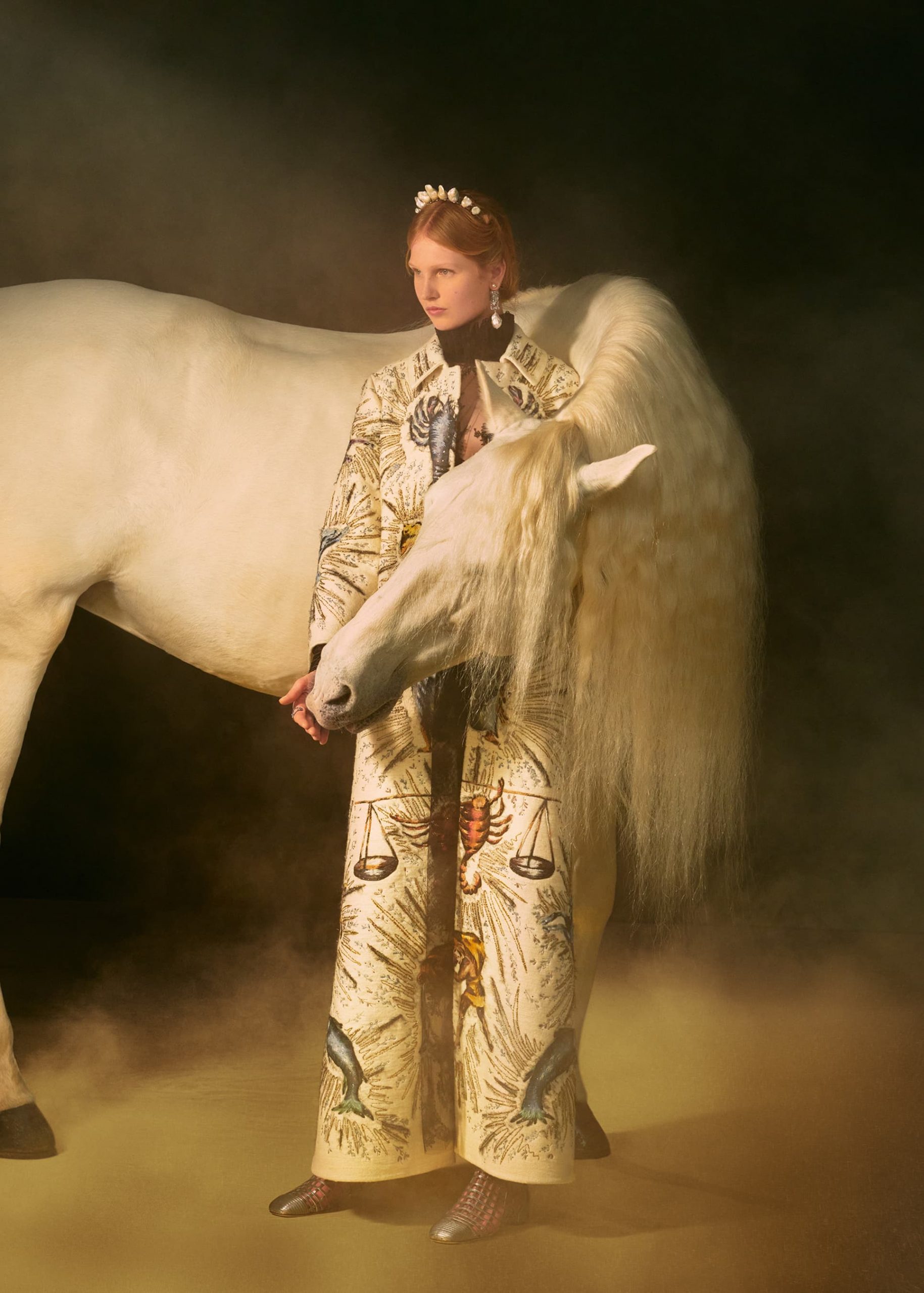
At Dior, there is still the idea of a fantastical fantasy allowing the carefully crafted couture clothes to take part in a journey, this time one of self-discovery, in a short movie made together with the filmmaker Matteo Garrone based around the story of a young girl picking a tarot card that initiated her entry into a castle full of wonderments. Maria Grazia Chiuri found her wonderful couture garments on the hand-painted tarots’ idea from the mid-1450s made by the artist Bonifacio Bembo Visconti-Sforza ducal families and the novel The Castle of Crossed Destinies by the Italian writer Italo Calvino.
Merging the Bembo cards’ visual imagery with the Calvino narrative, Chiuri created the spring collection knowing how the clothes would also work in the Garrone movie in this successful cinematic endeavor, the second joint Chiuri-Garrone film for Dior Haute Couture. That’s a critical element here, as so many of the fashion films fail to deliver, that if done harmoniously with the film narrative and cinematographic direction, the clothes can be part of the storytelling experience. Here, Chiuri dressed each of the Tarot card characters reenacted in the film in garments matching their roles – the Empress in a golden green long velvet zodiac print dress, the Strength wore a long silk lamé draped and pleated chartreuse dress, and the Wheel of Fortune wore a grey gauze corset with flower embroideries and layered skirt.
Le château du tarot, the Garrone movie, seamlessly connects Dior’s intellectual and artistic tradition to the new spring physical haute couture garments, traversing a very tough terrain of merging art and fashion that makes sense to the clothes and to the reasons for a particular choice of the kind of film work that can excite audiences, even beyond the fashion acolytes.
A week and a half after its premiere on the first day of the couture show calendar, I watched this Dior film again, out of the context of haute couture and fashion. Surprisingly, the film itself is far better and far superior when not viewed within the framework of a ‘fashion film’ and viewed as a film on its own. The clothes could not have been anything other than these Dior spring haute couture outfits in this new context.
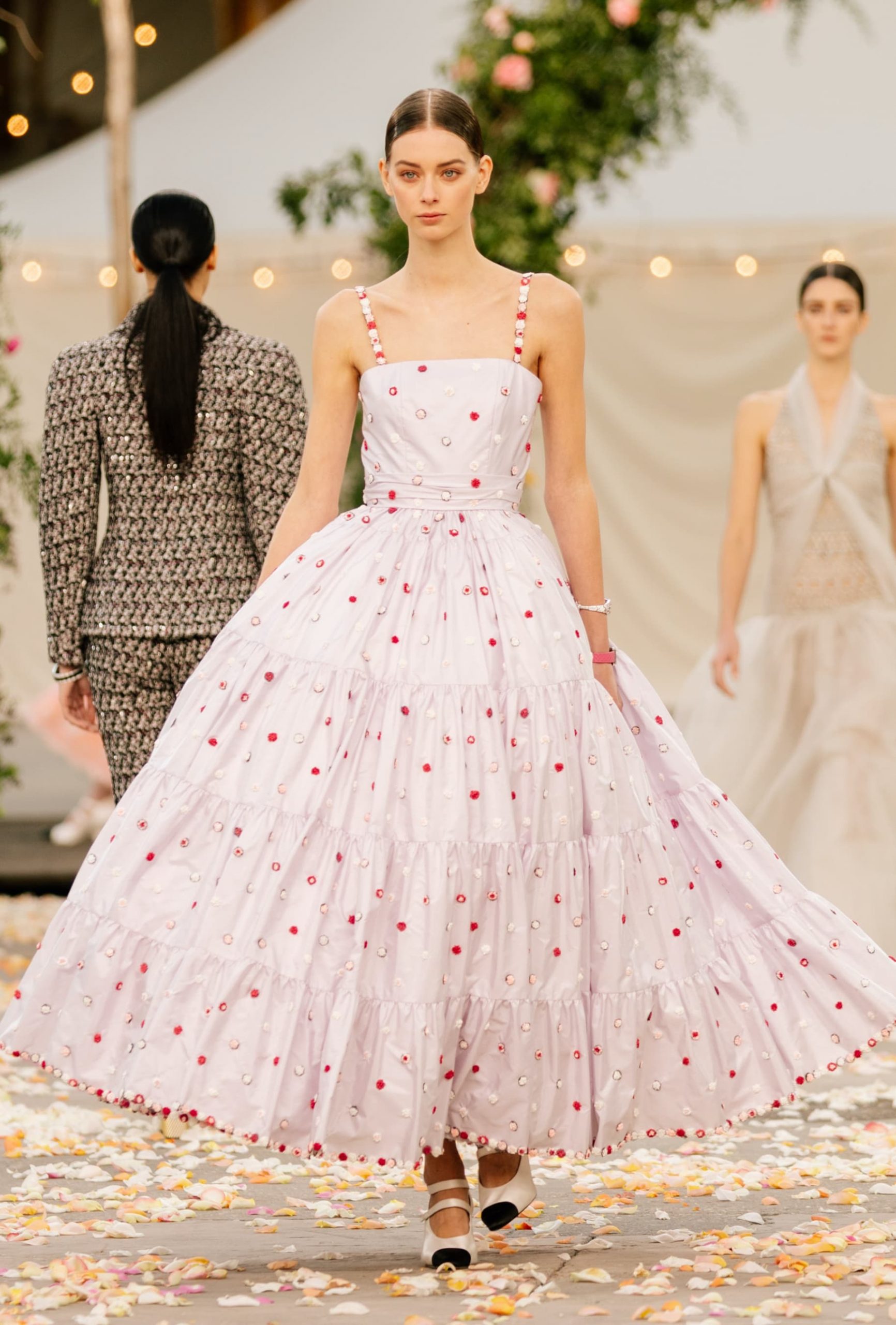
On the other side of the spectrum in the real world, Chanel engaged the visual art and film director Anton Corbijn to shoot the live show at the Grand Palais transformed into an intimate back garden in the south of France as a prerecorded taping release for the new great new clothes Virginie Viard, the creative director, made for this very focused and edited spring couture collection. Viard distilled any unnecessary embellishments to simplify the Chanel silhouette that featured the slim fitted vests/pants shape as the general day wear, and for the evening, a loose white silk blouse over a long black tulle skirt can suffice.
Presenting great clothes in daylight is more complicated than in the movie because the clothes are the prime and only center of attention. White hand-cut daisy flowers embroidered lace dress with detachable long skirt crystallized the thrust of this new Chanel haute couture collection – the wonderwork of the ateliers coupled with Viard’s mission to make Chanel’s signatures anew.
Pierpaolo Piccoli distills the Valentino haute couture methodology in aligning with Robert Del Naja from Massive Attack and the artist Mario Klingeman in an audiovisual artwork film then spring collection titled Code Temporal. The spring couture came in two parts – the first as a live stream regular fashion show staged at the Salla Grande inside the Galleria Colonna in Roma and the second portion as an audiovisual art film. In the second part, Del Naja composed the music in the documentary art film featuring shots of the Roman atelier seamstresses at work in their ritual processes of creating garments by hand and then filtered through the algorithms of Artificial Intelligence technology that learned these human processes and simplified these rituals of the atelier into the format of utter simplicity.
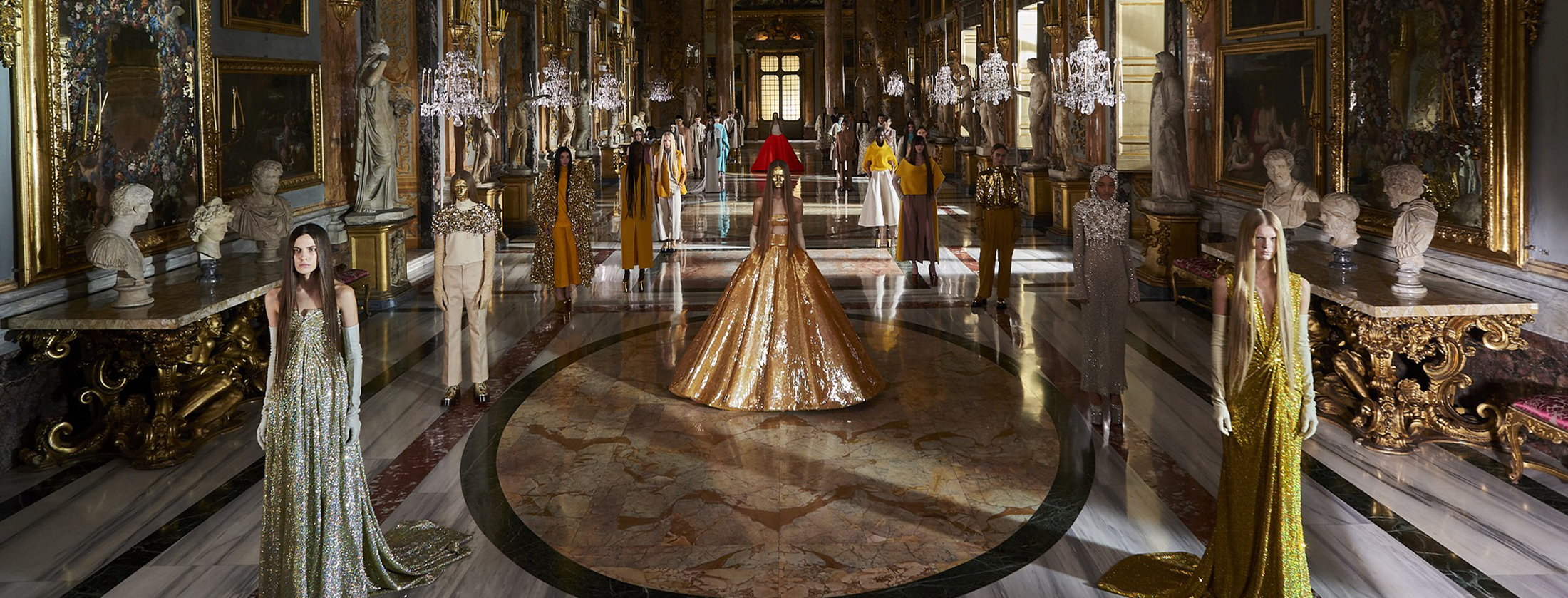
By inviting the artist-musician to the Rome atelier to film the course of the preparation of the spring collection, Piccioli transcribed the traditions of haute couture – the artisanal craftsmanships, the needles, and the hands – making these human gestures into musical notes in a collision with artificial intelligence technology for an audience not familiar with these techniques, and seeing these techniques performed in a different light and different circumstances.
“The analytical engine weaves algebraic patterns just as the jacquard loom weaves flowers and leaves,” was the typed message against a light grey background that opened the twelve minutes film Code Temporal before the camera zoomed in on the handiwork of one of the artisan seamstresses at Valentino Roma atelier with music by Del Naja and neurography by Mario Klingemann. “A stark distinction between inheritance and an open invitation to transmission,” continued the message, at times quoting Voltaire, Vivaldi, and Confucius as the work on various garments continued until the apotheosis.
Meanwhile, the seamstresses calmly cut, sow, and drape from morning until after nightfall, capping off the art film’s first segment. In the second half, the finished garments draped over mannequins shot in time-lapse sequences as complete show outfits. The last part is a conceptual edit re-set by algorithmic AI filters where remnants of fabrics and clothes become elements in an expressionist computer videogram.
By approaching this spring Valentino haute couture with a taped physical show and a visual art film, Piccioli achieved both the live showing of this grand collection of clothes that despite their complexities appeared fluid and straightforward and a film showing the backbone of couture not as a behind the scene peek but a long-form art project. It is like combining representational painting and abstract painting paths instead of diverging them into plural routes. The up-close inspection of the couture dressmaking process did not turn out to be dull after all, but rather a kind of idealism in its utter fidelity to the hand made, albeit one steep in reality and not the mythology of clothes.
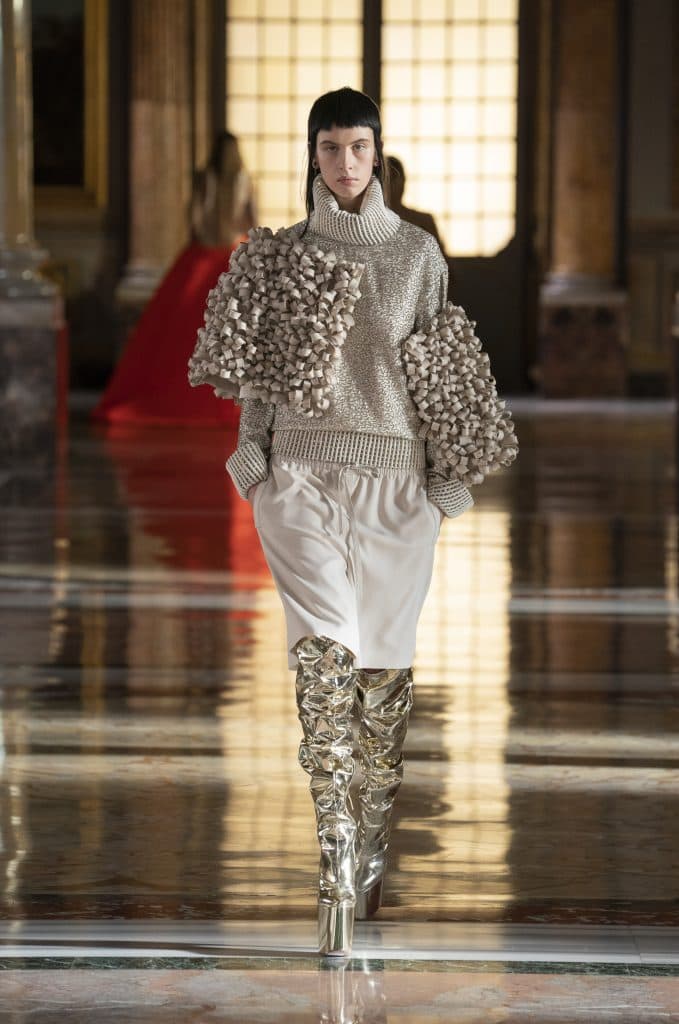
For Piccioli, haute couture is an act of conscience and an act of human ritual. The Roman designer is bringing the art of haute couture back to fashion very much like how Italian artists in the late fifteenth century – Michelangelo, Boccacio, Brunelleschi, Dante Alighieri – brought back ancient methods of paintings and the philosophy of humanism to usher in a new era known as the Renaissance.
Showing a cashmere cape coat made from individual square sewn together forming a pattern and a Fuschia cashmere off shoulder coat is merged with the underpinning corset, Piccioli is assuring the long-term viability of the institutional values of haute couture in this couture collection by linking the big act of couture with the quotidian act of dressing. Code Temporal is an art lesson in couture artisanal methodology, as well as in wearing fashion.
Iris van Herpen is another transformative voice whose work on couture for over a decade has affirmed the Dutch designer’s role in stirring couture towards a more extraordinary experimental form of fashion where she combined new technological innovation like 3D printing into her hand made garments bordering the poetic and the fantastic. Each season, Van Herpen dwelled deeply into a specific area to find new sculptural shapes that can translate into dressmaking. This time, the underside of the mushroom gives birth to a brown organza wavy cape over an embroidered tulle short dress or a dark marine blue cropped top with an organza dress that opened like folded blooming floral petals, the top made in conjunction with Parley for the Oceans fabrics from sea debris.
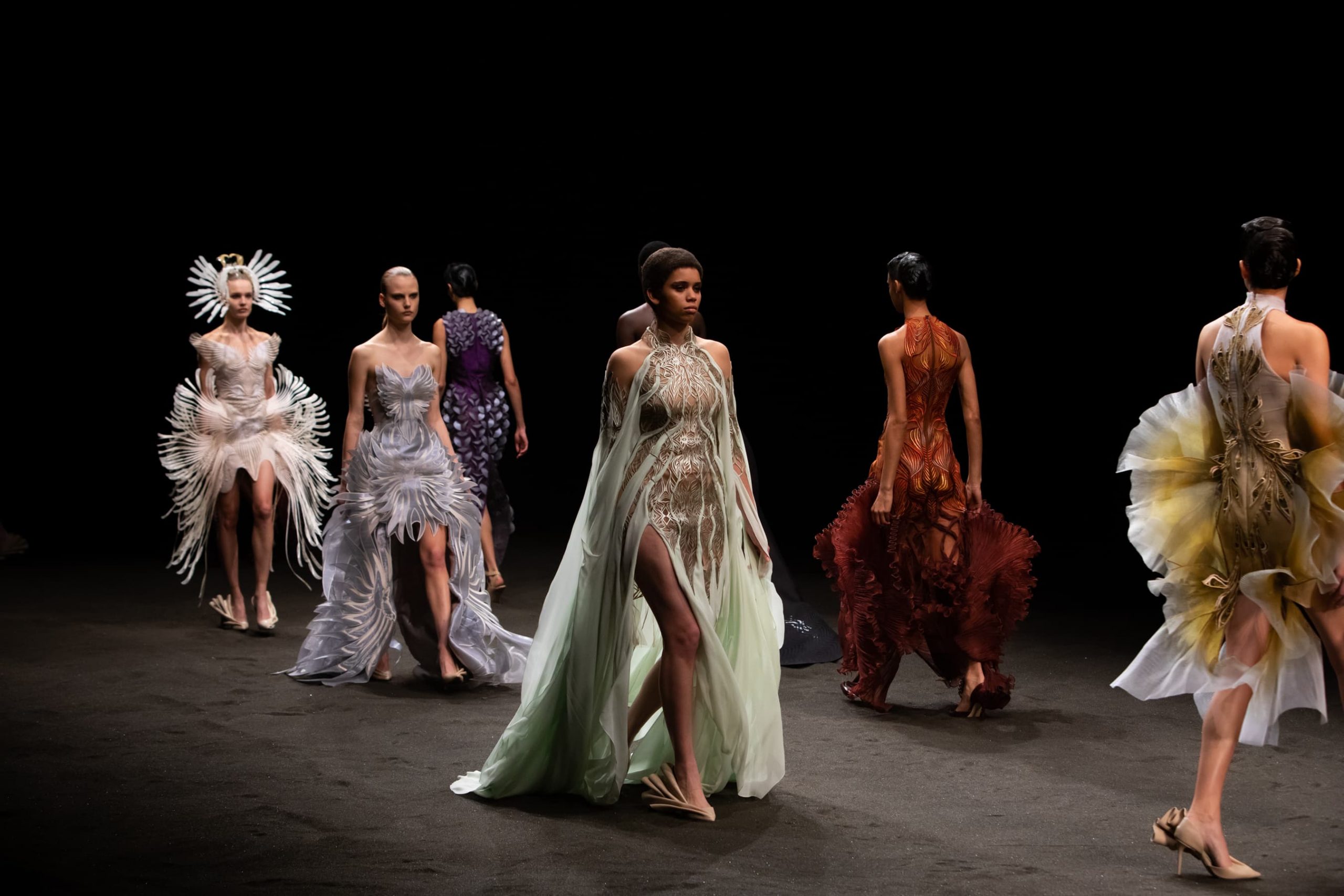
While van Herpen aligns her couture with technology and sustainability, repurpose and upcycling are the foundation for Ronald Van Der Kemp’s sustainable couture label founded in 2014 and for Viktor & Rolf, who since their ‘Vagabonds’ fall 2016 collection have turned to conscious couture as a way forward. Both brands use existing materials, remnants of clothes from past collection clothes, and vintage fabrics to create new and exciting clothes, such as RVDK’s long dress composed of midnight blue silk jacquard, black lace, and two types of silk leopard prints for his spring wardrobe 13 collections.
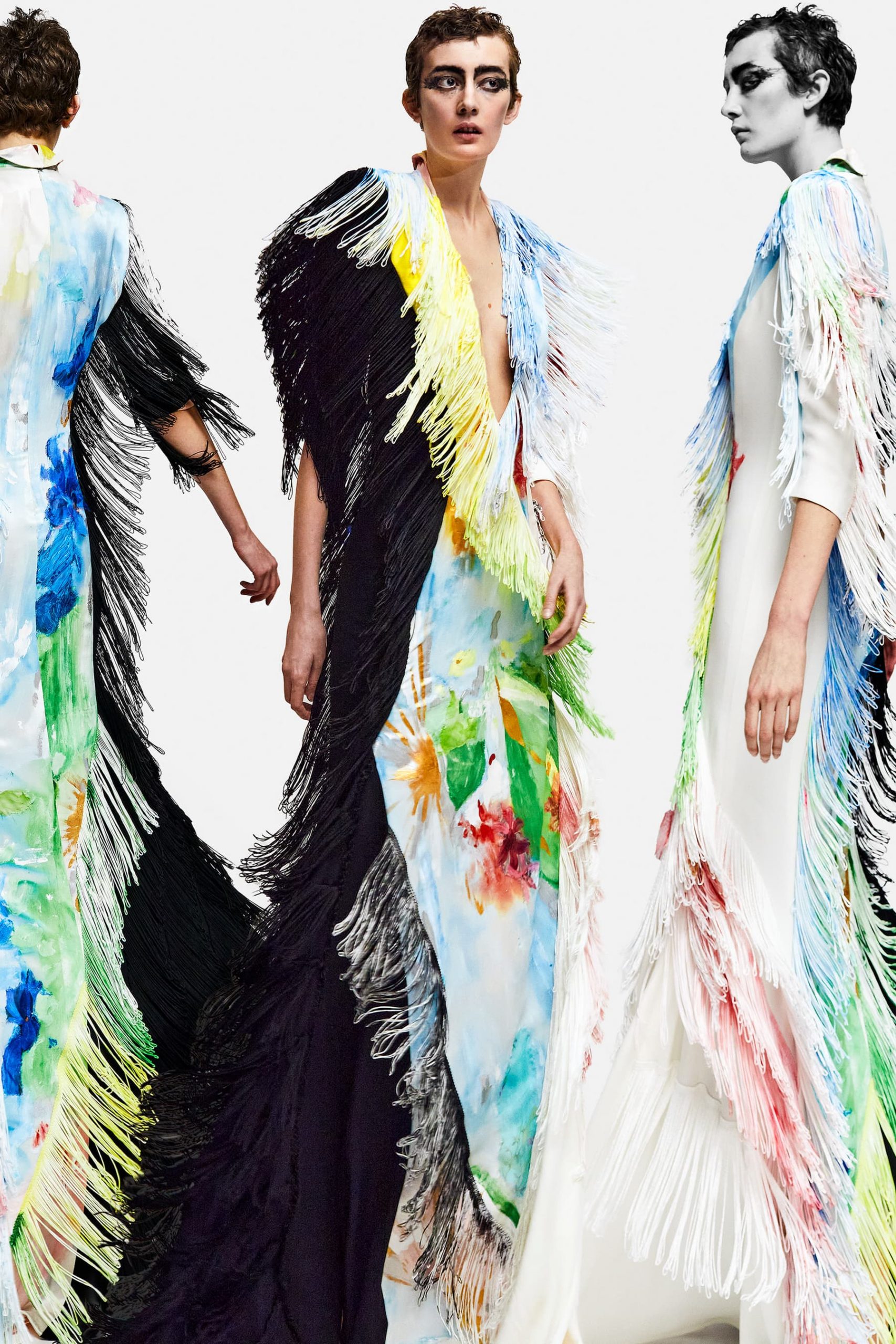
Ronald van der Kemp and Viktor & Rolf recently, Dutch designers contemporaneous as van Herpen, are embracing upcycling and repurpose and transiting haute couture into just about the crafts, artisanship, and less so the materials. They rejoined a concept first developed by Martin Margiela. In January 2006, the Belgian designer launched his Artisanal couture collection with garments like a jacket made from various colored vintage satin and velour cushions with embroidery and print motifs, the back of the coat was the entire side of a black velvet floral embroidered cushion with green fringes.
Martin Margiela’s Artisanal line of repurposed textiles and found objects into new ‘clothes’ as much as his replica of found garments were over a decade ahead of their time. The Belgian designer planted the seeds that van der Kemp can further push his ethical brand that espouses climate-conscious values.
Clothes often can represent the affirmation of the body over the brain. However, that is hard to say about the American designer Daniel Roseberry’s gimmicky garments created for Schiaparelli. The clothes screamed out loud noises, at least for a day or two, across the digital channels, without contributing much to advance haute couture in any measurable way. The collection is ‘full of sound and fury signifying nothing’ as the American author William Faulkner wrote in his 1929 novel.
A micro-short dress in the form of a brown leather muscle torso with matching tote is a sister to Jean-Paul Gaultier Homme spring 1988 version or the Fuschia muscle sequined dress that derived from the menswear work of the Belgian designer Walter Van Beirendonck’s work, especially his inflatable muscle jackets from his spring 1996 Composition collection.
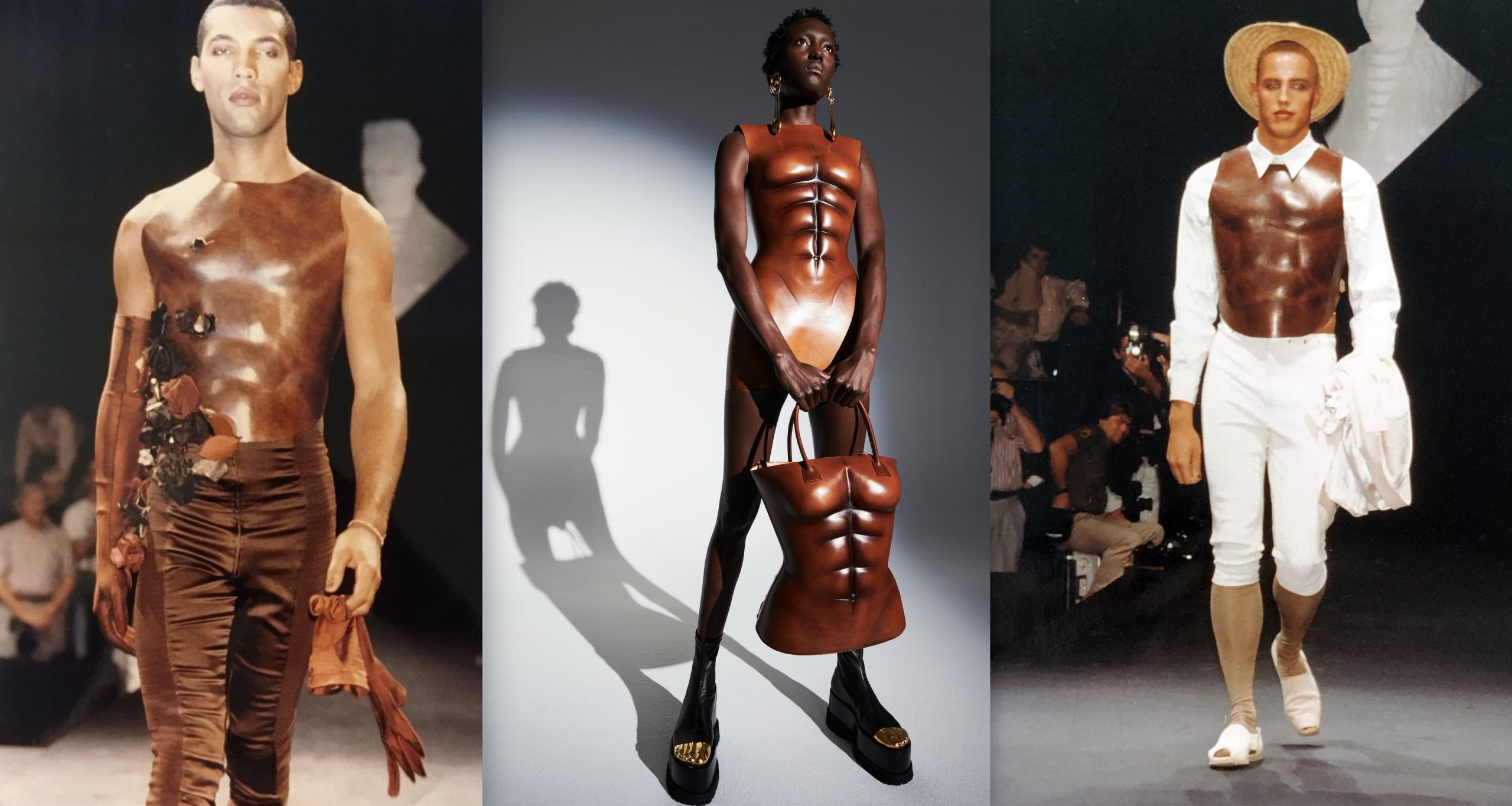
If Roseberry intended for his spring couture garments to reinforce the idea of women’s empowerment globally, then these stun clothes indeed accomplished the opposite by telegraphing the notion that women required these armored clothes made by male designers to achieve equal status. This collection isn’t ‘Girl Power.’ With little fuss, Yves Saint Laurent ushered a revolution by merely giving women the smoking and then the pantsuit to achieve equality, at least in the sartorial manner starting with the haute couture fall-winter 1966-1967 Pop Art collection and expanded with the ‘City’ tailored pantsuit and the safari in the following spring-summer 1968 show.
Besides the fact that some of these Schiaparelli spring looks owed allegiances to other designers’ work, they lacked the context and the irony of the original works. They have neither the shock values nor do they contain any deep level intuitions that required intellectual excavations. The clothes don’t evince real vision, not for the clothes, not for the fashion culture.
Haute couture is at a flexion point in fashion and in culture.
January 2021 wasn’t anything similar to January 2002, when one of the original haute couture modern practitioners sent out a 40 years retrospective of his work in his final runway show while others forecast the upcoming doomsday for high fashion. Today, couture is thriving in two senses – one, the heritages houses are attracting new crops of younger consumers across the globe in couture’s emerging markets. Secondly, the new group of independent designers redefines what couture is for their audience and community, not exactly accustomed to this genre of fashion’s travails. Both are critical to haute couture, just like the arteries and veins carrying blood and coming from the heart.
In this Spring 2021 season, both the heritage houses and the independents defy the business logic and the current crisis, offering vibrant ‘couture’ for their clients and fashion.
